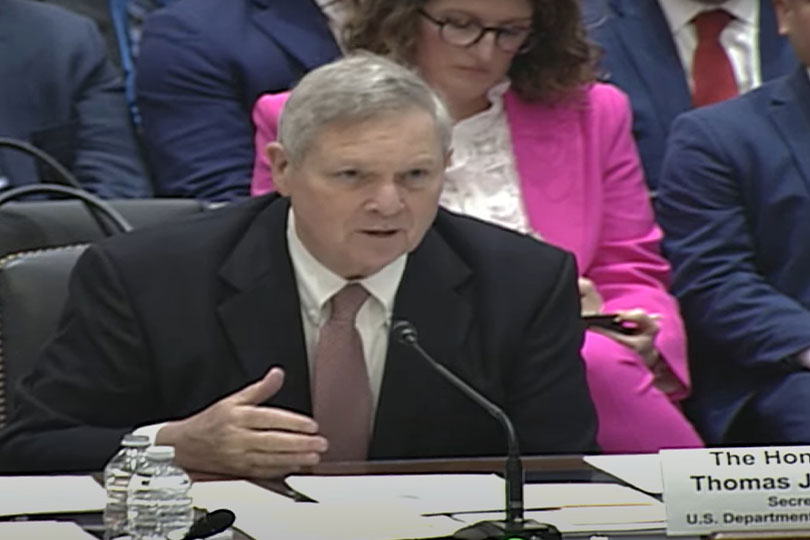By Jessica Domel
Multimedia Reporter
The chairman and former chair of the U.S. House Committee on Agriculture last week questioned U.S. Secretary of Agriculture Tom Vilsack on the “progressive factoring” used to determine farmers’ and ranchers’ disaster payments through the 2022 Emergency Relief Program (ERP).
“Ultimately, you’ve taken it upon yourself to utilize USDA to transform American agriculture through the unfettered use of the CCC (Commodity Credit Corporation) or rewriting the rules on disaster aid programs to reorient assistance to small and part-time farmers at the expense of full-time family farms,” Committee Chairman Glenn “GT” Thompson of Pennsylvania said.
According to the American Farm Bureau Federation (AFBF), the progressive factoring approach in ERP 2022 used a different payment formula for underserved and non-underserved farmers and ranchers—allowing higher payments for beginning, female and minority producers.
Vilsack told the committee the problem is the funding.
“When we advised Congress that there was a $10-$12 billion bill due to assist producers across the board for disasters in 2022, Congress appropriated $3 billion,” Vilsack said. “You gave us 30% of what we needed. We had a choice of basically doing it the way we did before when we had all the money and the resources to be able to cover all the producers or provide an opportunity for 80% of the producers to receive slightly more.”
Former committee chairman Frank Lucas of Oklahoma said the strongest policies that come out of the committee, and the most important programs administered by USDA, are built on the belief that support and relief programs must be tied to crop production.
“When this committee or your agency stray from that principle, we begin to walk down an unsustainable and concerning path,” Lucas said.
Lucas said he raised concerns with USDA before about using a formula that favored one group of farmers and ranchers over another.
“You said that your agency would learn from their experiences during the first iteration of ERP and would factor it into the administration of the next,” Lucas said. “Based on the reports I’m hearing from my producers in Oklahoma, ERP 2022 has proven to be no better than its predecessor at delivering support to those who suffered the greatest crop losses.”
Vilsack again pointed to the $3 billion allocated by Congress.
“When you give us 30% of what we ask for, when we tell you that the damages are $10-$12 billion, and you basically appropriate $3 billion, you put us in a tough spot,” Vilsack said.
Lucas said when USDA messed up the delivery of the $3 billion through the ERP funding model, it makes it difficult to come back to Congress and ask for the rest of the funding.
“I didn’t screw up at all,” Vilsack said. “In fact, 82% of the producers received more assistance and help than they would have based on what you’ve articulated.”
Vilsack told the committee not to cherry pick one program when looking at funding.
“You have to look at all of the resources that your producers received, including the crop insurance payments, the majority of which went to the people you’re talking about, which is a very small subset of the producers we’re talking about,” Vilsack said.
If faced with the same situation again, Vilsack said he wouldn’t change things.
“I would do it the same way because I think it’s helpful to help those smaller producers. Why? Because they didn’t receive the lion’s share of the $19 billion of indemnification that was paid through crop insurance and other mechanisms,” Vilsack said. “With all due respect, if you want the disaster programs to work, then we have to have the resources to be able to do what you want us to do, which is to make everybody whole.”
One of Texas Farm Bureau’s priority issues for the 118th Congress, second session, is to work to make certain disaster assistance is delivered in a timely, equitable and efficient manner.
“USDA rolled out the 2022 Emergency Relief Program, and it’s extremely flawed,” Laramie Adams, TFB associate director of Government Affairs, said. “Any time that you have a program that picks winners and losers based on criteria outside the farmers’ and ranchers’ control, you’re asking for issues.”
Adams said the organization understands USDA has to administer what they can with limited funds.
“We get that, but we work in Congress to try to get as much as we can to meet the needs of producers across the state and country based on something that’s outside, again, the farmers’ and ranchers’ control, and that’s the weather,” Adams said. “We have to make sure that these programs are being administered fairly, and unfortunately, this latest program coming a year late, and being administered in a way that we’ve not seen before, is really concerning.”
TFB continues to visit with lawmakers in Washington, D.C. about the challenges farmers and ranchers face with disaster assistance in hopes of trying to fix the issues.


Leave A Comment